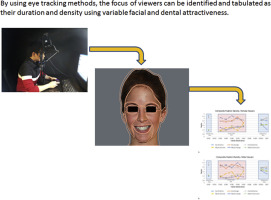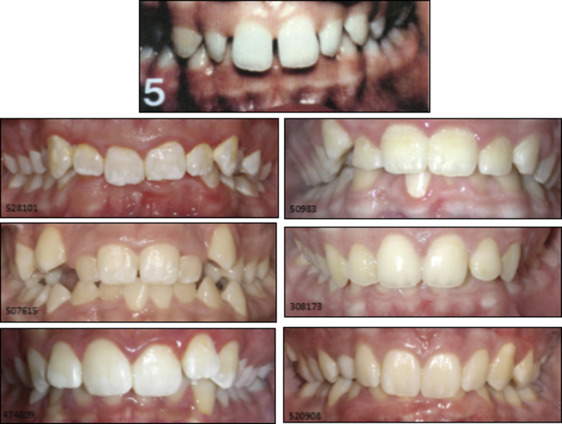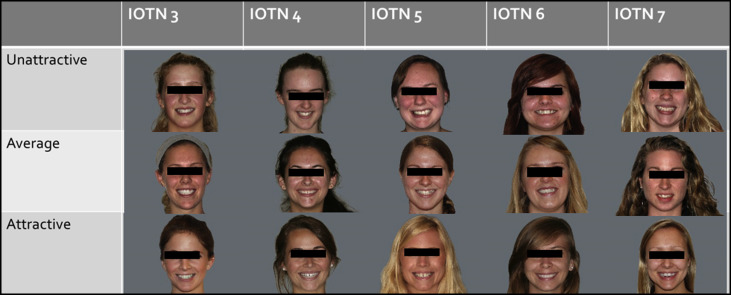Introduction
Previous eye-tracking research has demonstrated that laypersons view the range of dental attractiveness levels differently depending on facial attractiveness levels. How the borderline levels of dental attractiveness are viewed has not been evaluated in the context of facial attractiveness and compared with those with near-ideal esthetics or those in definite need of orthodontic treatment according to the Aesthetic Component of the Index of Orthodontic Treatment Need scale. Our objective was to determine the level of viewers’ visual attention in its treatment need categories levels 3 to 7 for persons considered “attractive,” “average,” or “unattractive.”
Methods
Facial images of persons at 3 facial attractiveness levels were combined with 5 levels of dental attractiveness (dentitions representing Aesthetic Component of the Index of Orthodontic Treatment Need levels 3-7) using imaging software to form 15 composite images. Each image was viewed twice by 66 lay participants using eye tracking. Both the fixation density (number of fixations per facial area) and the fixation duration (length of time for each facial area) were quantified for each image viewed. Repeated-measures analysis of variance was used to determine how fixation density and duration varied among the 6 facial interest areas (chin, ear, eye, mouth, nose, and other).
Results
Viewers demonstrated excellent to good reliability among the 6 interest areas (intraviewer reliability, 0.70-0.96; interviewer reliability, 0.56-0.93). Between Aesthetic Component of the Index of Orthodontic Treatment Need levels 3 and 7, viewers of all facial attractiveness levels showed an increase in attention to the mouth. However, only with the attractive models were significant differences in fixation density and duration found between borderline levels with female viewers. Female viewers paid attention to different areas of the face than did male viewers.
Conclusions
The importance of dental attractiveness is amplified in facially attractive female models compared with average and unattractive female models between near-ideal and borderline-severe dentally unattractive levels.
Graphical abstract

Highlights
- •
Dental attractiveness is tied to facial attractiveness.
- •
For borderline dental attractiveness, the trend was toward increased attention to the mouth.
- •
Attractive women were more influenced by borderline levels of dental attractiveness.
- •
Over the entire IOTN spectrum, attention to the mouth increased as dental attractiveness decreased.
Over the last several decades, we have witnessed an increasing emphasis on improvement of facial esthetics in orthodontic treatment planning. Research has established that the smile plays a role in overall facial attractiveness and can affect other personal attributes as well as the quality of social interactions.
Systematic reviews have outlined what morphologically defines an attractive smile. In whole-face studies, researchers have concluded that the background facial attractiveness of the model affects how these smiles were perceived, and the converse. Although there have been differing results among researchers in the contribution of the smile to facial attractiveness and overall attractiveness, there is evidence of an interaction.
A shortcoming in some full-face studies, however, was that the observer was directed to look specifically at characteristics of the mouth, and this can introduce bias. Only a handful of studies in the dental literature have evaluated the spontaneous response of viewers to facial features. In 2 recent orthodontic studies, researchers observed that subjects’ self-reported areas of viewing interest did not necessarily coincide with those they actually viewed. Furthermore, Hickman et al found that near-ideal (postorthodontic treatment) smiles did not receive much visual attention when placed in faces that were considered to be “well-balanced” with harmonious jaw relationships and features.
Richards et al incorporated different levels of dental attractiveness into different levels of facial attractiveness. These investigators showed that for female models, an unattractive smile received more visual attention compared with other facial areas in average and attractive faces when evaluated by eye tracking.
Eye tracking records a person’s gaze, location, and duration. Previous research noted a correlation between attractiveness and the ability to draw a person’s gaze and then hold it there for a given time. In eye tracking, viewers’ eye movements are tracked and recorded while they view images. Eye tracking is reliable in showing which features viewers view most frequently (fixation density) and how much time they spend viewing those features (fixation duration). This approach provides an objective method for evaluating which features are important to a viewer.
To define the levels of dental attractiveness in previous studies, investigators have used the Aesthetic Component (AC) of the Index of Orthodontic Treatment Need (IOTN). The complete IOTN (AC and Dental Health Component [DHC]) has been widely used in many countries to help prioritize the need for orthodontic treatment. It is used to quantify the functional and esthetic needs of patients.
The AC includes 10 levels of dental attractiveness based on esthetic impairment. It presents standards from 1 to 10 using color, and intraoral and frontal photographs. Level 1 is the most esthetic, and level 10 is the least esthetic. The levels are grouped into 3 treatment-need categories: “no/slight treatment need” (levels 1-4), “moderate/borderline treatment need” (levels 5-7), and “definite treatment need” (levels 8-10). The DHC ranks malocclusions in terms of the significance of tooth irregularities for a person’s dental health (levels 1-5). Levels 1 and 2 have no or little treatment need, level 3 has a moderate treatment need, and levels 4 and 5 have a definite treatment need.
One goal of the IOTN is to minimize the subjectivity related to assessing orthodontic treatment needs. Despite having “objective” measurement scales in the IOTN, there are questionable areas regarding the provision of treatment. Some clinicians have proposed that the most difficult decisions about treatment are those involving mild to moderate malocclusions (DHC) with esthetic implications (AC). Previous research has yielded different cutoff points for esthetic treatment needs in moderate-borderline grades of dental attractiveness. It has been proposed that when given a DHC score of 3—ie, the moderate DHC treatment need—the AC should carry particular significance as the deciding factor for treatment.
Richards et al showed that the degree to which a model’s smile draws the viewer’s attention depends on the model’s background facial attractiveness. They reported a significant difference in the attention paid to the mouth between AC-IOTN level 1 compared with AC level 7 for female models rated as average and attractive; there were no differences for unattractive women over this same range. There appears to be an expectation among viewers for consonance between facial attractiveness and dental attractiveness. When these are not in harmony, an unattractive smile is more noticeable.
In the AC-IOTN dental attractiveness category levels 3 to 7, it is unknown whether there is a gradient of increasing visual attention to the dentition as it becomes more unattractive or whether there is a critical point in the level of smile esthetics that draws significantly more visual attention. Furthermore, it is unknown how visual attention in this borderline region of dental attractiveness is affected by facial attractiveness.
The aim of this study was to determine the levels of viewers’ attention (number and duration of fixations) in the AC-IOTN treatment-need category levels 3 to 7 for faces that are considered attractive, average, and unattractive when evaluated using eye-tracking technology.
Material and methods
The Institutional Review Board of Ohio State University approved this study. The first step, image collection, was accomplished as in previous studies. This involved obtaining digital images of faces and sets of dentitions for AC-IOTN levels 1 to 10. The facial and dental images were then paired. This allowed us to present faces and dentitions that reliably represented their categories instead of searching for naturally occurring combinations. These methods are briefly described below.
Facial images of women, 18 to 30 years old, were obtained on a voluntary basis at a central campus public location. Two portraits for each woman were obtained using a digital single-lens reflex camera (D60; Nikon, Tokyo, Japan), 1 with a smile showing no teeth and 1 smiling with teeth exposed. Models with a significant distraction such as a facial tattoo, extreme hairstyle, extreme facial hair, asymmetry, abnormal piercing, or other notable characteristics were eliminated. Only images of white models were used to eliminate ethnicity as a variable.
After collection, 199 smiling facial images showing no teeth were rated by 36 young adults with no professional dental expertise. The photographs were rated as “attractive,” “average,” or “unattractive”: 3, 2, or 1, respectively, without further definition. Images of 41 models were divided into groups based on attractiveness.
The first group had a mean facial attractiveness less than 1.5, denoting unattractive; the second group had ratings close to 2 (1.878-2.41), denoting average attractiveness; and the third group had ratings of 2.5 or greater (attractive). Twenty-two of the 41 model images (54%) were rated twice for reliability.
Next, frontal intraoral images of dentitions of varying levels of dental attractiveness were obtained by searching the records of the University of Ohio’s clinical archive ( Fig 1 ). Each image was rated and assigned an IOTN level. The images were rated by experienced orthodontists (15 full-time and part-time faculty at the University of Ohio) to confirm the level of dental attractiveness. The goal was to obtain multiple similar images for levels 3 through 7 of dental attractiveness as defined by the AC-IOTN.

These raters viewed printed pages of the frontal, color, and intraoral photographs of the teeth and compared them with the standard IOTN photograph of this level of dental attractiveness placed at the top of each page. The orthodontists were asked to eliminate any image that they thought did not represent the standard. All images were rated twice to determine reliability.
Images of 3 levels of facial attractiveness were paired with 5 levels of dental attractiveness (AC-IOTN levels 3-7) ( Fig 2 ). This was accomplished using image processing software (Adobe Photoshop Elements 11.0; Adobe Systems, San Jose, Calif). This process resulted in 15 possible combinations of dental and facial attractiveness. The resulting images of the paired smiling faces and intraoral images displayed only the amount of the dentition that each smile allowed ( Fig 2 ).





